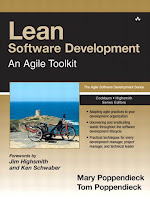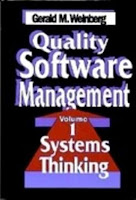I never stopped reading technical material, however this information’s usefulness is very contextual. You are not going to need a book on the C++ boost library if your project is implemented in Javascript for instance. I began to take a more targeted, just in time approach to technical information. There are many articles, books and resources however that are more broadly applicable and are worth proactively studying.
Here is my top ten must read books for anyone serious about software development.
The Mythical Man-Month: Essays on Software Engineering, (2nd Ed) by Frederick Brooks
by Frederick Brooks
The Fifth Discipline : The Art n Practice of The Learning Organization  by Peter Senge
by Peter Senge
It is tempting when embarking on a software project to rush into implementing the first solution proposed. However it is better to take the time to understand the problem domain and to understand the system the eventual solution needs to be a part of. The Fifth Discipline teaches a system thinking approach that can save your project from going down a blind alley.
Getting To Yes - Negotiating Agreement Without Giving In by Roger Fisher and William Ury
by Roger Fisher and William Ury
Sometimes you do not have the authority to remove road blocks that are crippling your project, especially if third parties are involved. It this case you need persuasion, influence and negotiation.
The Mythical Man-Month: Essays on Software Engineering, (2nd Ed)
Those who are blind to history are doomed to repeat it. This timeless classic helps you navigate around certain problems that crop up once your project reaches significant size and complexity. Technologies may change but dealing with people inside and outside the team, unknowns inherent in doing something new, and complexity involved capturing value beyond the obvious low hanging fruit, that hasn’t changed.
Everyone who has struggled with a piece of technology that does not work as they expected it to understands the value of good design. I have talked about this in more detail elsewhere. It is unfortunate that some developers blame users of their software for misunderstandings. The problems are usually not with the users but with the design of their software.
It is tempting when embarking on a software project to rush into implementing the first solution proposed. However it is better to take the time to understand the problem domain and to understand the system the eventual solution needs to be a part of. The Fifth Discipline teaches a system thinking approach that can save your project from going down a blind alley.
Getting To Yes - Negotiating Agreement Without Giving In
Sometimes you do not have the authority to remove road blocks that are crippling your project, especially if third parties are involved. It this case you need persuasion, influence and negotiation.
The Principles of Product Development Flow: Second Generation Lean Product Development
Whether is it the work involved in implementing your project, or the business processes interacting with or embedded within your problem domain, or the workflow and processes that your implementation encourages users to follow, concepts such as scheduling, workflow and queues are everywhere. This book will help you manage that flow. To quote the book -
“What actually works is surprisingly different from the standard advice.”Reinertsen's advice is non-standard, systematic, very detailed and very good.
Patterns : Elements of Reusable Object-Oriented Software
Shows a way of capturing proven reusable solutions for commonly occurring problems, solutions that have been reinvented over and over again by different software teams in different industries using different technologies. For many years my teams would study a different design pattern each week during the weekly brown bag lunches.
Allows you to safely keep your code flexible and easily modifiable.
Fearless Change : patterns for introducing new ideas
As a software developer you are automatically an agent of change (If you are successful that is. If your software doesn’t change anything that's a different problem). This book helps you introduce change into your organization.
Agile Retrospectives : Making Good Teams Great
If you don’t reflect on your experiences you are unlikely to improve. This book gives you the tools to systematically and regularly assess those experiences.
A startup environment has many differences from an established company. Startups are often in a customer search phase rather than a product development. This will impact how you approach software development in each environment.
The following books are close runners up to the top 10.
Working Effectively with Legacy Code
Not everyone has the luxury of working in a greenfield environment. It can be difficult to make changes to an established application that has no unit test without introducing breaking changes. This book gives you strategies to make changes safely.

Quality Software Management volumes 1
volumes 1 , 2, 3
, 2, 3 , 4
, 4 : by Jerry Weinberg
: by Jerry Weinberg
A smorgasbord of useful advice distilled from a long consulting career.
Limit work in progress and reduce cycle times.
Compares and contrasts many light-weight processes and gives evidence that they produce better results than heavy-weight processes.
Either introduce and remove patterns to your code without breaking anything.
Trust is the key. If your team is not working effectively together, then the chances of successfully completing your software project is greatly reduced.
Lean Thinking: Banish Waste and Create Wealth in Your Corporation by James P Womack and Daniel T Jones
Explains many of the core concepts of lean.
 Out Of The Crisis
Out Of The Crisis
How to manage variation. What is a significant incident and what is random noise. How to improve practises and processes in a systematic way. The original source of many lean concepts.



Lean Software Development: An Agile Toolkit by Mary and Tom Poppendieck plus it's sequels implementing and leading
Applying lean thinking to the software industry.
 Collaboration Explained: Facilitation Skills for Software Project Leaders
Collaboration Explained: Facilitation Skills for Software Project Leaders
Gives techniques for promoting collaboration and coordination.
 The Goal: A Process of Ongoing Improvement
The Goal: A Process of Ongoing Improvement
Uses narrative to explain flow and the effect of queues on systems. Less systematic than The Principles of Product Development Flow. Gives some theory behind the recommended practices but lacks the comprehensive theoretical framework contained in the other book.
The Effective Executive
It is all about priorities and making sure your behaviour matches your stated priorities.
Influence : Science and Practice
Sometimes you do not have the needed authority to achieve your objectives. As I said before you often need persuasion, influence and negotiation.
The Toyota Way : 14 Management Principles from the World's Greatest Manufacturer
Explains many of the core concepts of lean.
The World Is Flat : A Brief History of the Globalized World in the 21st Century
Some times in software development you need to interact with third parties. This book opened my eyes to alternative ways companies and organizations can coordinate with each other. Giving examples where these methods have been effective.
Update: 2025
The book covers where not showing and the links where broken. Should be all fixed.
























No comments:
Post a Comment